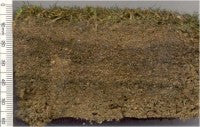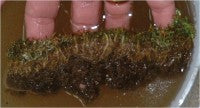Disease Analysis
I was talking to a delegate at a seminar recently who said, "I remember the time when the only turf disease we ever had was Fusarium patch". Now, I know that this disease (recently renamed as Microdochium patch) remains the most common and, arguably, the most damaging disease of cool-season turfgrasses, but I doubt that there was ever a time when this was the ONLY disease that we had.

However, it may have been the only one that was routinely diagnosed - and that got me thinking about the process of disease analysis and what you should expect from a lab.
We all know that, at some point in time, disease will develop, even on the best maintained turf areas. The organisms that have the ability to cause disease are always present in established areas and will naturally, and rapidly, colonise newly constructed areas, meaning that they are ready and waiting for the right conditions to initiate disease. However, the severity of disease expression will depend upon the strength of the plant at the time of infection and its ability to tolerate and overcome it.
That said, once symptoms appear, the correct identification of their cause is imperative if the correct and most effective management options are to be implemented. You will be able to recognise the disease problems that reoccur on your turf but, if you are in any doubt about the cause, you may consider sending a sample of the damaged turf for analysis.
But what should you expect from the analysis result?
When it comes to disease identification, there is as much emphasis on you as the turf manager to provide appropriate turf samples for analysis as there is for the lab to accurately identify the problem. In most cases, the best place to remove a turf sample for analysis is from the leading edge of the symptoms, where the affected or discoloured plants give way to healthy turf.
It is also important for the lab to be able to see what the general composition and condition of the sward is like and what the rootzone profile is like and, for those reasons, a 90mm diameter core sample, taken to a depth of approximately 60mm using a golf hole changer (or similar) makes for an ideal sample.
The turf core should be kept intact by wrapping it tightly in dry newspaper and packing it in to a box for posting. Next day delivery can be guaranteed and the sample should arrive at the lab in good condition for analysis. If the symptoms develop rapidly on the turf area, any lab would appreciate you sending two or three turf samples to show the different stages of development, but they should only charge you for one analysis - after all, it's only one problem that they are investigating for you.
If possible, email some photographs of the symptoms so that the lab can get an idea of how the problem is developing - a good picture can often tell so much more than a detailed written description.
If you have provided the best possible sample for analysis, the least that you should expect from any lab is that they provide the best possible analysis service, i.e. a rapid, accurate and complete analysis. Many of the fungi that cause disease on turfgrasses produce mycelial characteristics and spores, in addition to the visible symptoms on the plants, which will aid identification of the problem.
Care must be taken by the lab not to merely identify the presence of a fungus but to determine whether that fungus is actually causing disease and that is where the problem lies, especially with labs that specialise in areas other than amenity turf.
Many fungi that cause disease in turf also exist quite happily as saprophytes at the base of the sward and feed on the dead and decaying material. I would bet that you can find Microdochium nivale, for example, in all turf but does that mean that it's always causing disease? No! Disease identification should include observation of the affected plants and the symptoms on the leaf, stem, crown and root tissues, identification of the fungi that are actively present, recognition of the environmental conditions and an appreciation of how the symptoms have developed since they initially appeared.
There are a few fungi that cause disease but don't produce spores and, without spores, the identification of the fungus becomes more difficult. Fungal spores are like the fingerprint of a fungus. Different fungal genera will produce different shaped, sized and coloured spores and, within each genus, the spores of the different fungal species will show characteristics that allow them to be further identified.
Without spores, a lab will have to rely on information relating to the prevailing conditions, the symptoms on the plant, the grasses affected and the mycelial characteristics of the fungus to help with identifying the problem. The fungus can be grown on an artificial medium in the lab but this takes time and, without the additional backup of DNA analysis on the isolated fungi, the analysis result may be more tentative.
Fortunately, this does not cause a problem very often, as many of these non-sporing fungi grow differently on specific culture media and they can be identified once the fungi are grown. The concern that I have is that these fungi tend to cause disease rapidly and spread quite quickly so, waiting for the fungi to be isolated and grown up in the lab, could mean that the turf has suffered significant damage by the time the result is provided.
Disease analysis all sounds relatively straightforward, so what could go wrong? Frequently, samples are received with no sender details so the results can't be forwarded until someone calls in to see where the result is.
Turf samples are packed too loosely and get thrown around in the post. The sward becomes covered with rootzone which speeds up the decay of the turf, the sample becomes broken apart, different samples within the same outer box get mixed up so we don't know what sample we are analysing.
Bulked tine cores are received for identification of a foliar disease. Tine core samples contain very few intact plants and, without intact plants, a root problem cannot be ascribed to a grass type in a mixed sward. Worse than that, the plant material begins to decay as soon as it is severed from the roots and, by the time the plants reach the lab, the initial symptoms of disease may be masked by decay.
Bulked tine core samples should only be sent if the rootzone is to be checked for plant parasitic nematodes. For this type of analysis, tine cores are ideal because they can be bulked from across and around the affected areas (and a similar sample should be sent from a healthy area for comparison) providing a more representative sample than a single core.
That said, not all labs will check for the presence of plant parasitic nematodes, so it is worth asking before you make the effort to send the samples.
Different labs will use slightly different methods
Different labs will use slightly different methods to analyse the turf for disease, and these methods will have been determined by the staff in relation to the quantity of material that they have to analyse, the quality of the received samples, the requested analysis and the cost of the work.
However, the different labs should provide the same result - the cause of the damage to the turf. In some cases, symptoms on received turf samples can resemble those of certain diseases but, following analysis, the cause is found to be physiological or related to the local conditions or recent applications. In such circumstances, the best result that can be achieved from a disease analysis is confirmation that the problem is not caused by a fungus or parasitic nematode and, if necessary, a referral to laboratories that will be able to check for certain other causes should be provided.
The different methods employed by labs will inevitably produce slightly different results, but this is not in itself anything to be too alarmed about. In the case of fungal disease identification, the differences between labs should not be that great however, it depends on whether th e lab looks for only the most obvious problem or whether it checks out potential additional or contributory problems as well.
e lab looks for only the most obvious problem or whether it checks out potential additional or contributory problems as well.
For example, a sward may show symptoms typical of Take-all patch and a sample may be sent in for confirmation of this disease. The fungus that causes this Take-all patch can readily be identified in the lab but, the affected plants may also show a secondary infection of Anthracnose, for example. If this secondary infection is also reported, the turf manager will be aware that a susceptible sward may develop a more significant Anthracnose disease in the coming months.
One similar situation occurred in my lab towards the end of last year when turf samples were received for confirmation of the fungal disease Microdochium patch. The symptoms, shown in photo 1, were typical of Microdochium patch development and it was relatively quick to confirm that the sward was 'alive' with the spores of Microdochium nivale. 
As a matter of course, I checked the rootzone and, on first appearance, there did not appear to be a problem (photo 2). However, on feeling the strength profile, I considered that it was much weaker than might have been expected. It was a quick test to gently separate the turf from the rootzone and take a look at the roots. As you can see from photo 3, the root quality was very poor and far less than may have been expected from a mature turf. An extraction and analysis of the rootzone and of the washed roots identified a very high population of the Cyst nematode, Heterodera.
What was actually happening in this situation was that the Cyst nematode was feeding on the roots, weakening the root structure and reducing nutrient and water uptake in to the plant. With the plants becoming increasingly weakened, the leaf tissues were increasingly susceptible to the Microdochium patch.

If the full result of the analysis had only been that the fungal disease was confirmed, I have little doubt that repeated fungicide applications would have been made to the affected turf which would continually succumb to fungal infection.
Having been able to identify the main cause of the problem, i.e. the weakening of the turf due to the nematode feeding, management of the turf was focussed on increasing plant strength, reducing the nematode population and reducing the overall stress on the sward. Ultimately, this approach would strengthen the turf, lessen the outbreaks of Microdochium patch and reduce total fungicide input.
Where are we now with disease diagnosis?
We can identify the fungi that are associated with disease and, by considering the symptoms, and development of the symptoms, we can determine what the main problem is at any given time. In my opinion, a complete disease analysis should look for the possible influence of all pathogens, and that includes parasitic nematodes.
The presence of these parasites does not necessarily mean that you will see symptoms of disease on the turf. As with all diseases, the symptom expression is affected by environmental and host conditions. If the turf is strong, a large population of parasitic nematode can be present with negligible effect on turf quality. That said, if the turf is weak, a low population can have quite dramatic results. When assessing for nematode involvement in disease, it is important to assess the quality of the root system in addition to determining the population of the nematode.
Never underestimate the importance of the background information or symptom history that you provide when requesting a disease analysis. It should help the lab to know the type of problems to look for and, if the suspected problems are not found or the symptoms are not consistent with those that are typical of a given disease, you should expect that the lab to try to find out why.
If you decide to send turf to a lab for analysis, work with the lab to provide them with all of the relevant information that can help confirm the problem. For their part, the lab should take seriously their obligation to provide a rapid, accurate and complete analysis service to help you best manage your turf.
To get the best result from a turf disease analysis:
• Take one or more representative samples to provide the best material for the lab to analyse
• Package the samples so that the turf does not get contaminated by the rootzone if you want a foliar fungal disease analysis
• Pack bulked 20mm diameter cores tightly in a sealed plastic bag to prevent the sample drying out if you want a parasitic nematode analysis
• Label the samples so that you can relate the results to where the samples were taken from
• Include your contact details
• Inform the lab that the samples are being sent and email photographs of the symptoms, if possible
• Provide a brief summary of the problem, e.g. chlorotic patches appeared across the pitch (evenly distributed) two weeks ago and have increased rapidly in diameter since they first appeared. Fungicide X was applied one week ago but there has been no change in the symptoms
• Send the samples by next day delivery wherever possible to ensure that the samples are as fresh as possible when they arrive at the lab.
Dr. Kate Entwistle, The Turf Disease Centre
Email: kate@theturfdiseasecentre.co.uk
www.theturfdiseasecentre.co.uk
